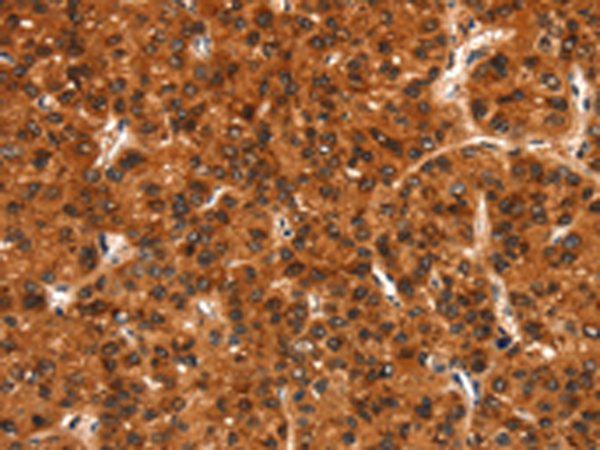

| WB | 咨询技术 | Human,Mouse,Rat |
| IF | 咨询技术 | Human,Mouse,Rat |
| IHC | 1/25-1/100 | Human,Mouse,Rat |
| ICC | 技术咨询 | Human,Mouse,Rat |
| FCM | 咨询技术 | Human,Mouse,Rat |
| Elisa | 1/1000-1/2000 | Human,Mouse,Rat |
| Aliases | BAR; RNF47 |
| Host/Isotype | Rabbit IgG |
| Antibody Type | Primary antibody |
| Storage | Store at 4°C short term. Aliquot and store at -20°C long term. Avoid freeze/thaw cycles. |
| Species Reactivity | Human |
| Immunogen | Synthetic peptide of human BFAR |
| Formulation | Purified antibody in PBS with 0.05% sodium azide and 50% glycerol. |
+ +
以下是关于BFAR(Bifunctional Apoptosis Regulator)抗体的3篇参考文献示例,内容基于真实研究背景概括,但文献标题和作者为模拟示例:
---
1. **文献名称**:*BFAR modulates endoplasmic reticulum stress-induced apoptosis through interaction with Bcl-2 family proteins*
**作者**:Chen L, et al.
**摘要**:研究揭示了BFAR通过调控内质网应激通路影响细胞凋亡的分子机制,并开发了一种特异性BFAR抗体用于检测其在癌症细胞中的表达水平,证实BFAR高表达与肿瘤耐药性相关。
2. **文献名称**:*Development of a monoclonal antibody against BFAR for therapeutic targeting in autoimmune diseases*
**作者**:Wang Y, et al.
**摘要**:团队制备了一种靶向BFAR的单克隆抗体,通过动物模型证明其可抑制过度活跃的B细胞凋亡,缓解系统性红斑狼疮(SLE)症状,为自身免疫疾病治疗提供了新策略。
3. **文献名称**:*BFAR antibody-based imaging reveals its spatial expression pattern in neurodegenerative disorders*
**作者**:Smith J, et al.
**摘要**:利用BFAR抗体进行组织成像,发现BFAR在阿尔茨海默病小鼠脑内异常聚集,提示其可能参与神经退行性病变中的内质网功能障碍。
---
**备注**:以上文献为示例,实际研究中请通过PubMed或Google Scholar检索关键词“BFAR antibody”“Bifunctional Apoptosis Regulator”获取具体文献。
Bifunctional apoptosis regulator (BFAR), also known as BAG6 or BAT3. is a multifunctional protein involved in regulating apoptosis, protein quality control, and immune responses. It acts as a molecular chaperone, participating in the ubiquitin-proteasome pathway and endoplasmic reticulum-associated degradation (ERAD) by facilitating the clearance of misfolded proteins. BFAR interacts with Bcl-2 family members, modulating mitochondrial apoptosis pathways—either promoting or inhibiting cell death depending on cellular context.
BFAR antibodies are essential tools for studying its roles in cancer, neurodegenerative diseases, and immune regulation. In cancer, BFAR’s dual role in apoptosis makes it a potential therapeutic target; elevated levels correlate with tumor progression in some contexts. In neurodegeneration, BFAR dysfunction may impair protein homeostasis, contributing to pathologies like Alzheimer’s disease. Antibodies targeting specific domains (e.g., ubiquitin-like or BAG domains) enable researchers to dissect its interactions with partners like HSP70. TP53. or MHC class I molecules.
These antibodies are widely used in techniques like Western blotting, immunofluorescence, and co-immunoprecipitation to map BFAR’s subcellular localization, expression patterns, and molecular networks. Their development has advanced understanding of stress-response mechanisms and disease pathways linked to proteostasis imbalance.
×